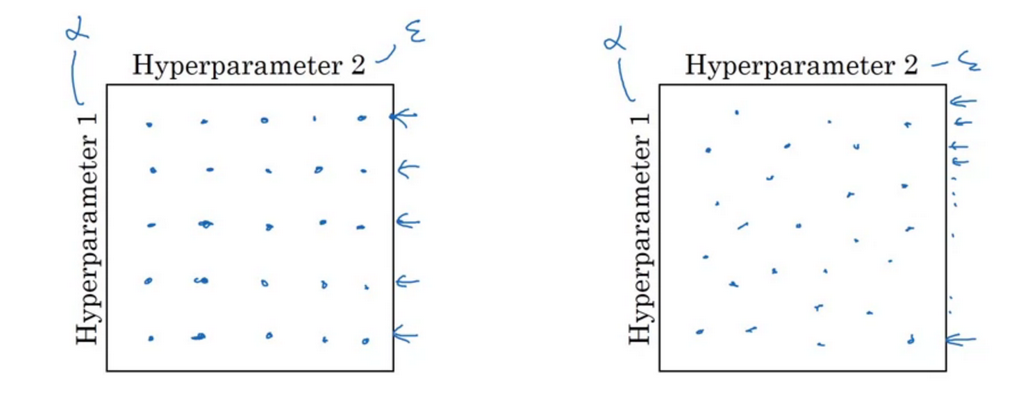Hyperparameters Tuning and Batch Normalization - Class review
Last updated on:3 years ago
Once you have constructed your learning system, you have to tune its hyperparameters. The number of set of parameters means how many models you should train.
Tuning process
- Hyperparameters: $\alpha, \beta, \varepsilon$.
- Layers
- Hidden units
- Learning rate decay
- Mini-batch size
Try random value
Don’t use a grid. Picking hyperparameters at random. Grid search can be used for the number of hidden units and layers.

Coarse to fine

Using an appropriate scale
Appropriate scale for hyperparameters
$$r = -4 * np.random.rand()$$
$$\alpha = np.power(10, r)$$
Exponentially weighted averages, don’t choose it in linear scale
$$choose 1 - \beta$$
$$1 - \beta = 10^r$$
$$\beta = 1 - 10^r$$
It is more sensitive to change $\beta$ when it is close to 1.
| $\beta = $ | 0.9 | … | 0.999 |
|---|---|---|---|
| 10 | 1000 | ||
| $1-\beta =$ | 0.1 | … | 0.001 |
$$\beta: (0.9000 \to 0.9005) ~10$$
$$\beta: (0.999) ~ 1000 \to (0.9995) ~ 2000$$
Hyperparameters tuning in practice: Pandas vs. Caviar
Intuition does get scale, re-evaluate occasionally.
- Babysitting one model, Panda
- Training many models in parallel, Caviar
Normalizing activations in a network
Normalizing inputs to speed up learning, batch norm
$$z^{(i)}_{norm} = \frac{z^{(i)} - \mu}{\sigma^2 + \varepsilon}$$
$$\tilde{z}^{(i)} = \gamma z^{(i)}_{\text{norm}} + \beta$$
If $\gamma = \sqrt(\sigma^2 + \varepsilon)$
$\beta = \mu$
then, $\tilde{z}^{(i)} =z^{(i)}$
Why does batch norm work?
Learning on shifting input distribution
Batch norm: no matter how it changes, it eliminates the amount of updating parameters in the earlier layer that can affect the distribution of values.
The earlier layer doesn’t change much, has the same mean and variance
Reduce the problem of input value changing, this value becomes more stable
Batch norm at test time
$\mu, \sigma^2$: estimate using exponentially weighted average (across mini-batches)
$$X^1, X^2, X^3, …$$
$$\mu^{1}[l]$$
Using data from training set.
Fitting batch norm into a neural network

$$\beta^{[l]} = \beta^{[l]} - \alpha d\beta^{[l]}$$
Working with mini-batches

Mean subtraction will get rid of the constant.
Parameters:
$$\omega ^{[l]}, \cancel{b^{[l]}}, \beta ^{[l]}, \gamma ^{[l]}$$
$$z ^{[l]} = \omega ^{[l]} a^{[l - 1]} + \cancel{b^{[l]}}$$
Softmax
Multi-class classification
Softmax layer
$$ Z^{[L]} = W^{[L]} a^{[L-1]} + b^{[L]} $$
Activation function
$$ t = exp(z^{[L]}) $$
$$a^{[L]} = \frac {exp(z^{[L]})} {\sum^4_{i=1} t_i}$$
Training a softmax classifier
Hardmax $[1 0 0 0]^T$
Softmax, more gentle mapping
Softmax regression generalizes logistic regression to C classes.
Loss function
$$L(\hat{y}, y) = - \sum^4_{j=1} y_j \log \hat{y}_j$$
Cost function
$$J(\omega^{[1]}, b^{[1]}, …) = \frac{1}{m} \sum^m_{i=1} L(\hat{y}, y)$$
$$Y = [y^{(1)}, y^{(2)}, …, y^{(l)}]$$
$$\hat{Y} = [\hat{y}^{(1)}, \hat{y}^{(2)}, …, \hat{y}^{(l)}]$$

Reference
[1] Deeplearning.ai, Improving Deep Neural Networks: Hyperparameter Tuning, Regularization and Optimization
本博客所有文章除特别声明外,均采用 CC BY-SA 4.0 协议 ,转载请注明出处!